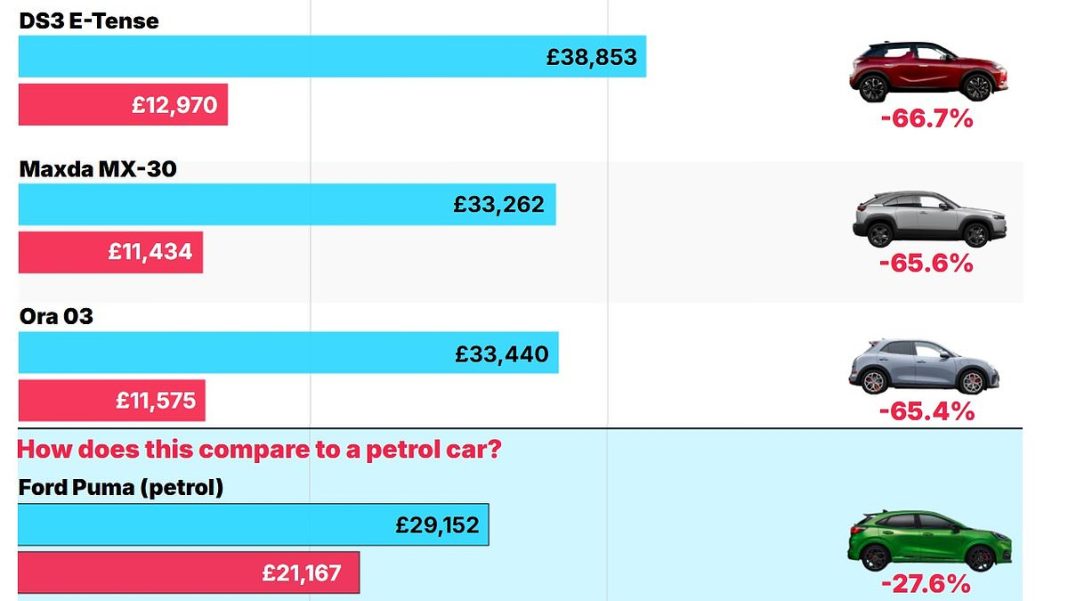Some electric cars are worth as little as a third of their initial price – the equivalent of shedding £26,000 – after just 12 months, with This is Money revealing the 20 models with the most appalling residual values.
EVs in general have suffered catastrophic depreciation since the end of 2022 when a cocktail of issues sent used prices into a downward spiral.
This perfect storm hit almost simultaneously, involving a cost-of-living crisis, rocketing energy prices, hard-hitting media coverage of EVs, an oversupply of vehicles entering the second-hand market, and Tesla slashing new model prices.
It quickly brewed into a destructive tornado for used electric car values.
Three years later, this punishing depreciation is still hitting EV values – and to the tune of tens of thousands of pounds for owners who bought them outright and leasing and financing companies burdened with undervalued vehicles, according to data shared with This is Money and MailOnline.
Cap hpi – experts in the field of vehicle pricing – provided us with market information showing troubling EV residual values compared to cars of other fuel types, while also revealing the models that hemorrhage the most money after only 12 months.
To understand what’s stalling a recovery for second-hand EV prices, we also spoke to industry insiders to get their perspective on the crippling impact for the motor sector.
How much faster are EVs depreciating?
To understand just how rapidly EVs are leaking value, cap hpi provided data across all fuel types comparing their average new price and what a year-old model with 10,000 miles on the clock is worth.
The average EV loses 43.2 per cent of its initial price over this 12-month period. In monetary terms, it means the resale value of a year-old EV is typically £25,900 less than the recommended retail price the owner paid.
How does that compare to other fuel types?
| Fuel Type | Avg depreciation (%) | Avg depreciation (£) |
|---|---|---|
| Hybrid | -30.4% | -£12,511 |
| Diesel | -31.3% | -£17,478 |
| Petrol | -31.5% | -£17,951 |
| Plug-in Hybrid | -36.3% | -£28,885 |
| Electric | -43.2% | -£25,901 |
| Source: cap hpi | ||
Hybrids are holding their value best, losing only 30.4 per cent (around £12,500) of their RRP in the first year.
New diesels – which are incredibly rare now that car makers have slashed their availability on emissions grounds – are also holding value far more strongly than EVs, shedding 31.1 per cent (or just under £17,500) of their original cost.
Buyers of petrol cars can expect to see 31.5 per cent of the retail price wiped from their motor’s value after the first 12 months, which is the equivalent of £18,000.
And it’s plug-in hybrids that are depreciating at a rate closest to EVs, ditching 36.3 per cent of their value, which is a typical loss against the RRP of nearly £29,000 after one year.
The biggest upshot of this whole situation is that used EV models are now extremely affordable – and year-old examples are now far more cost-effective to run than other fuel types, having swallowed most of their loss in residual value already.
Ginny Buckley, chief executive of EV-dedicated website Electrifying.com told us: ‘It’s bad news for anyone who’s paid full price for a new EV, but great for used buyers who love a bargain.
‘In many cases, nearly-new [up to 12 months old] EVs are now the same price – if not cheaper – than petrol equivalents.’
Which EV models shed most value in 12 months?
Below is the countdown of the 20 electric cars that lose the most value in the first year, with a detailed look at the top 10 biggest fallers.
When we asked cap hpi what makes these particular models shed value quicker than others, it said one of the biggest factors is that they were available in ‘high volumes’ during the period when EV values initially started barrel-rolling – around late 2022 and early 2023.
Another contributor to their poor residual value is that many were launched with both a small and larger battery option, with the former much cheaper but far less appealing to used buyers.
‘The smaller battery option looks inferior to rivals in term of range and charging capability, and these were often superseded by slightly larger, more efficient batteries,’ Dylan Setterfield, head of forecast strategy at cap hpi, tells us.
This combination of factors is why the 20 EVs listed below shed between 53 per cent and almost 67 per cent of their value in 12 months.
| Model | Price new | Value after a year | Value lost | Depreciation (%) | |
|---|---|---|---|---|---|
| 20. | Peugeot e-Traveller (2020-) | £53,876 | £25,112 | -£28,764 | -53.4% |
| 19. | MG ZS EV (2019-2024) | £32,941 | £15,287 | -£17,654 | -53.6% |
| 18. | Fiat e500C (2020-) | £35,140 | £16,233 | -£18,907 | -53.8% |
| 17. | Citroen e-C4 X (2022-) | £33,721 | £15,306 | -£18,415 | -54.1% |
| 16. | Subaru Solterra (2022-) | £53,940 | £24,775 | -£29,165 | -54.1% |
| 15. | Honda e:Ny1 (2023-) | £46,040 | £20,100 | -£25,940 | -56.3% |
| 14. | Vauxhall Combo e-Life (2021-) | £34,022 | £14,800 | -£19,222 | -56.5% |
| 13. | Honda e (2020-2023) | £37,340 | £16,150 | -£21,190 | -56.7% |
| 12. | Fiat 500e (2020-) | £31,107 | £13,175 | -£17,932 | -57.7% |
| 11. | Citroen e-C4 (2020-) | £32,890 | £13,661 | -£19,229 | -57.8% |
| Source: cap hpi | |||||
10. Peugeot e-2008 (2020-) – depreciates 58.3%
Price new: £38,374
Value after a year: £12,970
Depreciation: -£22,381
Peugeot’s small crossover model takes a huge financial hit in the first 12 months, losing 58.3 per cent of its value, which is the equivalent to £22,380.
That’s a big loss on a model that customers on average pay over £38,000 for.
It was originally launched in 2020 with a 50kWh battery offering a range of 192 miles. An update since has upped this smaller battery range to 201 miles, while a 54kWh battery option provides up to 250 miles between charges.
9. Peugeot e-208 (2019-) – depreciates 59.4%
Price new: £33,757
Value after a year: £13,694
Value lost: -£20,063
The Peugeot e-2008’s smaller sibling fares even worse than the crossover, with the e-208 French supermini shedding 59.4 per cent of its RRP after a year on the road with average mileage.
With an average residual loss of £20,000, the depreciation in the first 12 months is more than the price of a new petrol engined 208 (£19,995).
When it debuted in 2019, its lone 50kWh battery option provided up to 211 miles of range. This has been increased and a bigger 54kWh pack available now extends the distance between charges to 268 miles.
8. MG 5 EV (2020-) – depreciates 59.7%
Price new: £32,191
Value after a year: £12,975
Value lost: -£19,216
In terms of practical electric family cars, there are few models as capable – and affordable – as the MG 5 EV. Sold exclusively as an estate, it has bounds of passenger and luggage space.
But that doesn’t prevent a first-year collapse in value, with customers typically paying £32,191 for a new one, which is then worth just £12,975 12 months later. That’s over £19,000 lost, which is effectively giving away more than £1,500 a month on what is already a budget-end electric family car.
When it launched it came with a 52kWh battery supplying a range of 214 miles. A major facelift and overhaul in 2023 means customers can get their hands on one with almost 300 miles of range.
7. Vauxhall Corsa-e (2020-) – depreciates 61.6%
Price new: £33,282
Value after a year: £12,690
Value lost: -£20,592
Given the Peugeot e-208’s appearance already in this list, it’s somewhat unsurprising to find its sister model from Vauxhall also making the order, though with a more significant one-year value decline of 61.6 per cent.
Vauxhall will hope its recent facelift – and a Long Range spec offering 266 miles of range between changes – will give it a boost, but for now cap hpi shows it shifting £20,500 of its original £33,330 average new price after 12 months.
That means owners who buy a Corsa-e outright can expect it to be worth just £12,700 when it turns a year old. In comparison, a year-old petrol Corsa, which was cheaper to buy new by depreciates far slower, is on average £3,600 more expensive.
6. Vauxhall Vivaro e-Life (2020-) – depreciates 61.7%
Price new: £49,859
Value after a year: £19,017
Value lost: -£30,842
The Vivaro e-Life is Vauxhall’s answer to a large MPV with coach-like passenger capacity of up to nine seats. With a claimed range of just 141 miles, it’s relatively limited in terms of driving distances on a single charge.
This might be one of the factors impacting its poor residual value performance.
It loses 61.7 per cent of the new price in 12 months, leaving owners of a near-£50k battery-powered MPV with an asset worth only £19,000 after one year.
5. Vauxhall Mokka-e (2020-) – depreciates 62.4%
Price new: £36,945
Value after a year: £13,793
Value lost: -£23,152
Completing a hat-trick of electric Vauxhall’s in this list is the Mokka-e – the compact crossover version of the Corsa, and the sister car to the Peugeot e-2008 (in tenth in this list).
Offering up to 252 miles of range today, it originally launched in 2020 with a smaller battery providing as little as 197 miles between charges.
With customers typically paying £37,000 for a new example, after 12 months it will have lost over £23,000 in value – that’s depreciation of 62.4 per cent. This makes a year-old Mokka-e £4,500 cheaper than a Mokka petrol after the same amount of time and mileage.
4. Nissan Leaf (2017-2024) – depreciates 64.8%
Price new: £29,940
Value after a year: £10,544
Value lost: -£19,396
This month, This is Money had an exclusive first look at the new third-generation Nissan Leaf, which is due to be delivered to customers in spring 2026.
To prepare for its arrival, production of the previous-gen car ceased last year, and it is this ageing EV that’s covered here. When it debuted in 2017, it could go no further than 168 miles between charges. However, upgrades over the year – including the 2019 arrival of the Leaf+ – upped the range to 239 miles.
Given it is incredibly long in the tooth by relative electric vehicle standards today, it’s not at all surprising to see the outgoing Leaf ranked fourth in this list for rapid depreciation. Though 12-month value loss of 64.8 per cent is still incredibly concerning.
3. Ora 03 (2023-) – depreciates 65.4%
Price new: £33,440
Value after a year: £11,575
Value lost: -£21,866
Ora is a Chinese newcomer. The brand is part of the Great Wall Motor conglomerate, which is a powerhouse in the EV market in East Asia.
The 03 is its debut model for the UK with a compact size, oddball looks and even stranger launch name of ‘Funky Cat’. Its limited range of 193 miles and steep pricing [by Chinese brands’ standards] has made it less appealing to used buyers.
Losing almost two thirds of its new price, owners can expect to see £21,900 disappear from its value in the first 12 months.
2. Mazda MX-30 (2020-) – depreciates 65.6%
Price new: £33,262
Value after a year: £11,434
Value lost: -£21,828
The MX-30 is Mazda’s attempt to wade into the compact electric SUV market with a stylish retro design and suicide doors.
But there is one limiting factor of this family-friendly Japanese EV that’s almost certainly restricted its appeal to driver – and that’s its range. At an official 124 miles, it far shorter than rivals and could be one of the main reasons why second-hand prices have been slashed to make them more appealing.
It means a new one, typically costing £33,260, sheds £21,800 of that value in the first year. That’s depreciation of 65.6 per cent in 12 months.
1. DS3 E-Tense (2019-) – depreciates 66.7%
Price new: £38,853
Value after a year: £12,970
Value lost: -£25,883
Citroen’s electric hatchback sold today has a range of up to 248 miles on a full charge – though when it launched in 2019 it could only go for 200 miles before a fresh dose of electricity. Despite its relatively practical performance for such a compact car, residual values are exceptionally weak.
For a new model costing on average almost £39,000, owners after one year have an automotive asset valued at less than a new Dacia Sandero (Britain’s cheapest car), having lost almost £25,900 over the course of 12 months.
Depreciation of 66.7 per cent makes this the fastest price faller of all models.
Why are EVs ravaged by hefty depreciation?
As EV values continue to drop like a stone in the first year, we’ve examined what’s having such a significant detrimental impact on used prices.
Before speaking to a panel of experts who are well informed on the challenges at play, it’s important to point out that depreciation is directly linked to demand – and many Britons simply do not want to own an electric car… ever.
A recent poll of 1,500 UK drivers commissioned by AXA insurance found that almost two thirds (63 per cent) are not interested in purchasing an EV in their lifetime.
However, contrasting reports have put the proportion of motorists unwilling to switch much lower.
And various surveys of those who have converted to life with battery cars already has found that the vast majority won’t be back-tracking on that decision, with some studies saying that as many in nine in ten EV owners won’t buy a petrol of diesel model again.
Unlike the new car market, which is having its hand forced by policy makers to ditch conventional internal combustion engines by 2030, drivers who don’t want an EV have ample options available to them on the used market – and will do so for decades to come.
That said, with no supply from new registrations, prices will ultimately increase for quality used internal combustion engine cars if motorists are scrambling to get their hands on one.
How long they will be able to do so is another big question, with no date rubberstamped for the ban on sales of used petrol and diesel cars – though it has been suggested the 2050 Net Zero ambitions will see them outlawed.
For now, used EVs also face the same stigmas as new models, with driver concerns about range anxiety, a lack of charging infrastructure, and many not having off-street parking to allow them to charge more cheaply using a wallbox installed at their homes instead of the more expensive public network.
But experts say one of the biggest factors restricting the rebound for used EV values is the current level of discounting of new electric cars.
With manufacturers under intense pressure to meet the Government’s Zero Emission Vehicle (ZEV) mandate – the annually-increasing EV sales targets set out for the next decade – they have been slashing the price of models to make them more attractive to buyers.
The Society of Motor Manufacturers and Trader (SMMT) claims car makers swallowed £4billion in losses associated to discounted EV pricing last year – and are on course to lose billions again this year as ZEV targets increase for 2025.
Cap’s forecast expert Dylan Setterfield says nearly new prices are also being compounded by other deals offered with new EVs to increase their appeal.
He told This is Money: ‘When a substantial financial discount on the new car is combined with 0 per cent finance and other elements such as free wall box charging units, complimentary servicing costs, and a large amount of free electric charging through a partner supplier, a new EV often ends up being cheaper than a nearly new used car, with the inevitable effect on used values.
‘Although there are some exceptions, these incentives are not typically applied to used cars.
‘Even after these new car offers are removed, the used values are unlikely to recover from their reduced level as the market has already been set.’
Quentin Willson, the former Top Gear host turned EV campaigner for the FairCharge group, said discounted new electric car prices are just part of a wider issue.
‘Over supply of EVs from fleets into the used market, and mainstream drivers not understanding technology, have also combined to cause heavier than expected depreciation,’ he told us.
James Buxton, chief exec at car360 – the UK’s largest sole used EV dealer network in the UK selling around 5,000 electric models per year – also blamed significant depreciation on a ‘market imbalance’ being created by a flood of used EVs from lease operators.
Earlier this year, the British Vehicle Rental and Leasing Association (BVRLA) warned that car finance and leasing companies are losing ‘hundreds of millions’ of pounds at the hands of the rapid depreciation of electric vehicles, the trade body has warned.
In a letter penned to the Government’s Transport Select Committee, it said the sector has been the driving force behind EV growth but is now being left to ‘shoulder’ massive losses resulting from plummeting residual values.
Toby Poston, BVRLA’s chief executive, told us: ‘Month after month, used EV prices are continuing to fall. This is costing fleets and leasing companies millions upon millions of pounds, eroding confidence across the second-hand market, pushing up new electric vehicle prices and acting like a drag anchor on the whole zero emission vehicle transition.
‘Things have become so volatile and costly that fleets are trying desperately to avoid putting their BEV stock into the used market – by leasing them again or extending existing leases.
‘The number of used electric vehicles hitting the market is already outstripping demand, but we know that even that ‘supply’ figure is artificially low because companies are holding back from defleeting to avoid crystalising their depreciation losses.’
Quentin Willson also believes misinformation surrounding battery life being a major contributor to second-hand EV demand shrinking and anchoring prices, with drivers believing degradation is far more severe than studies have shown.
He pointed to research from Geotab published last year – based a review of 5,000 EVs – that suggested that a typical EV battery degrades by 1.8 per cent each year, and says this will slow as more advanced technology emerge.
Another market impact is the slump in demand for Tesla cars as public opinion on CEO Elon Musk has taken a major detour.
Buxton, who said cars360 sold a record 400 used EVs last month, told This is Money: ‘Tesla’s woes have dragged the rest of the market down because they’re still the largest volume player in the used car space. But these lower priced Teslas are now getting stronger enquiries.’
So, how do EV converts avoid such crippling deprecation.
Steve Walker, head of digital content at Auto Express, tells us: ‘We’ve seen EV technology evolve very quickly with longer ranges, shorter charge times and lower purchase prices for new cars all making used models bought years, or maybe only months, ago look less attractive.
‘The trick from a consumer point of view is to seek out today’s top EV models; cars using the latest technology with long-term desirability built in.
‘Then use the dealers’ burning need to sell and a bit of careful haggling to get yourself a great deal.
‘That’ll help mediate some of the huge depreciation, but future residual values will always depend to a great extent on where the car market rollercoaster goes next.’






